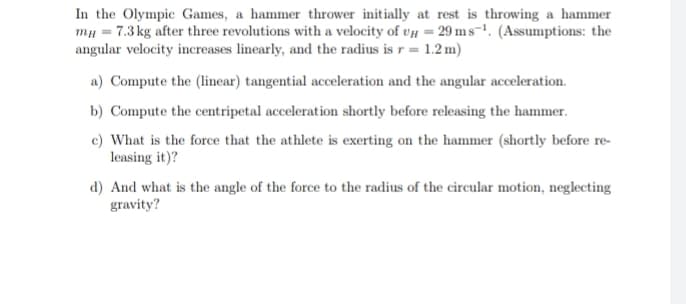In the Olympic Games, a hammer thrower initially at rest is throwing a hammer my 7.3 kg after three revolutions with a velocity of v 29 ms¹. (Assumptions: the angular velocity increases linearly, and the radius is r= 1.2 m) a) Compute the (linear) tangential acceleration and the angular acceleration. b) Compute the centripetal acceleration shortly before releasing the hammer. c) What is the force that the athlete is exerting on the hammer (shortly before re- leasing it)? d) And what is the angle of the force to the radius of the circular motion, neglecting gravity?
In the Olympic Games, a hammer thrower initially at rest is throwing a hammer my 7.3 kg after three revolutions with a velocity of v 29 ms¹. (Assumptions: the angular velocity increases linearly, and the radius is r= 1.2 m) a) Compute the (linear) tangential acceleration and the angular acceleration. b) Compute the centripetal acceleration shortly before releasing the hammer. c) What is the force that the athlete is exerting on the hammer (shortly before re- leasing it)? d) And what is the angle of the force to the radius of the circular motion, neglecting gravity?
International Edition---engineering Mechanics: Statics, 4th Edition
4th Edition
ISBN:9781305501607
Author:Andrew Pytel And Jaan Kiusalaas
Publisher:Andrew Pytel And Jaan Kiusalaas
Chapter1: Introduction To Statics
Section: Chapter Questions
Problem 1.19P: Plot the earths gravitational acceleration g(m/s2) against the height h (km) above the surface of...
Related questions
Question
Do all parts

Transcribed Image Text:In the Olympic Games, a hammer thrower initially at rest is throwing a hammer
mg = 7.3 kg after three revolutions with a velocity of UH = 29 ms-¹. (Assumptions: the
angular velocity increases linearly, and the radius is r= 1.2 m)
a) Compute the (linear) tangential acceleration and the angular acceleration.
b) Compute the centripetal acceleration shortly before releasing the hammer.
c) What is the force that the athlete is exerting on the hammer (shortly before re-
leasing it)?
d) And what is the angle of the force to the radius of the circular motion, neglecting
gravity?
Expert Solution
This question has been solved!
Explore an expertly crafted, step-by-step solution for a thorough understanding of key concepts.
Step by step
Solved in 5 steps with 5 images

Knowledge Booster
Learn more about
Need a deep-dive on the concept behind this application? Look no further. Learn more about this topic, mechanical-engineering and related others by exploring similar questions and additional content below.Recommended textbooks for you

International Edition---engineering Mechanics: St…
Mechanical Engineering
ISBN:
9781305501607
Author:
Andrew Pytel And Jaan Kiusalaas
Publisher:
CENGAGE L

International Edition---engineering Mechanics: St…
Mechanical Engineering
ISBN:
9781305501607
Author:
Andrew Pytel And Jaan Kiusalaas
Publisher:
CENGAGE L